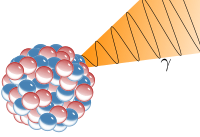
Photo from wikipedia
Significance Even though bright X-rays below mega-electron volt photon energy can be obtained from X-ray free electron lasers and synchrotron radiation facilities, it remains a great challenge to generate collimated… Click to show full abstract
Significance Even though bright X-rays below mega-electron volt photon energy can be obtained from X-ray free electron lasers and synchrotron radiation facilities, it remains a great challenge to generate collimated bright gamma-ray beams over 10 mega-electron volts. We propose a scheme to efficiently generate such beams from submicron wires irradiated by petawatt lasers, where electron accelerating and wiggling are achieved simultaneously. With significant quantum electrodynamics effects existing even with petawatt lasers, our full 3D simulations show that directional gamma rays can be generated with thousand-fold higher brilliance and thousand-fold higher photon energy than those from synchrotron radiation facilities. In addition, the photon yield efficiency approaches 10%, 100,000-fold higher than those typical from betatron radiation and Compton scattering based on laser-wakefield accelerators. Even though high-quality X- and gamma rays with photon energy below mega-electron volt (MeV) are available from large-scale X-ray free electron lasers and synchrotron radiation facilities, it remains a great challenge to generate bright gamma rays over 10 MeV. Recently, gamma rays with energies up to the MeV level were observed in Compton scattering experiments based on laser wakefield accelerators, but the yield efficiency was as low as 10−6, owing to low charge of the electron beam. Here, we propose a scheme to efficiently generate gamma rays of hundreds of MeV from submicrometer wires irradiated by petawatt lasers, where electron accelerating and wiggling are achieved simultaneously. The wiggling is caused by the quasistatic electric and magnetic fields induced around the wire surface, and these are so high that even quantum electrodynamics (QED) effects become significant for gamma-ray generation, although the driving lasers are only at the petawatt level. Our full 3D simulations show that directional, ultrabright gamma rays are generated, containing 1012 photons between 5 and 500 MeV within a 10-fs duration. The brilliance, up to 1027 photons s−1 mrad−2 mm−2 per 0.1% bandwidth at an average photon energy of 20 MeV, is second only to X-ray free electron lasers, while the photon energy is 3 orders of magnitude higher than the latter. In addition, the gamma ray yield efficiency approaches 10%—that is, 5 orders of magnitude higher than the Compton scattering based on laser wakefield accelerators. Such high-energy, ultrabright, femtosecond-duration gamma rays may find applications in nuclear photonics, radiotherapy, and laboratory astrophysics.
Journal Title: Proceedings of the National Academy of Sciences of the United States of America
Year Published: 2018
Link to full text (if available)
Share on Social Media: Sign Up to like & get
recommendations!